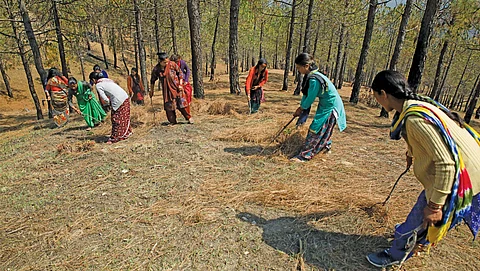

Since early December 2024, about six groups from the Uttarakhand forest department, each with 50 officials, have visited the forested village of Shitlakhet. During their day-long visit to the village, located in Almora district in the state’s Kumaon region, they interact with local communities to understand the strategies used to save their forests from being razed by fires.
These strategies are part of the “Shitlakhet model”, first highlighted by the Uttarakhand Chief Minister Pushkar Singh Dhami in 2022. In June 2024, the Head of Forest Forces, Uttarakhand, acknowledged the effectiveness of this public participation model in minimising the damage to forests during the fire season (March to mid-June) and directed that it be emulated across the state. This has given the communities a boost of confidence, says Gajendra Pathak, a pharmacist from Shitlakhet village. Since 2019, he has been heading Jungle Ke Dost (friends of the forest), comprising residents of 30 villages in the region that helped form the Shitlakhet model. “Our practices have potential to grow,” he says.
Explaining the practices, he says, “Our group primarily consists of women and young farmers who are connected via WhatsApp. Upon hearing about a forest fire, we rush to the scene and inform other local communities and the forest department.”
The group also takes preventive measures ahead of the fire season, such as clearing dried grass and leaves that are easily flammable. “In the spring, farmers burn dried leaves and bushes to clear fields for kharif sowing. Due to negligence, the flames can spread to forests. To mitigate this, we encourage farmers to clear the fields by March 31, before dryness sets in,” says Pathak. In another measure, the group helps curb felling of trees to make wooden ploughs, by providing iron ploughs to nearly 10,000 farmers in nine hilly districts. The Vivekananda Hill Agriculture Research Institute in Almora helped in this move. Jungle Ke Dost also spreads awareness on forest conservation and fire management, as well as on practices such as assisted natural farming, in which natural growth of vegetation on degraded land is facilitated without excessive intervention.
“All these practices were followed in smaller groups since 2004, before we came together as Jungle Ke Dost. I estimate that for the past 12 years, we have all collectively conserved 500 hectares of forest land,” says Pathak.
In recent years, Plus Approach Foundation, a non-profit in Delhi, has aided the initiative by awarding women from 10 villages and providing financial support. “Forests need year-round conservation, and we need more support from the state government and fire department, through insurance, fire-resistant clothing and fire-fighting equipment,” says Sonia Bisht of Kharkiya village in the district, associated with Jungle Ke Dost.
This was first published in the 1-15 February, 2025, print edition of Down To Earth